Haluski (Cabbage and Noodles) – Easy, Frugal Comfort Food
This post may contain affiliate links. Read my full disclosure here.
This traditional haluski recipe is an Eastern European comfort food that is rich and filling. It’s a great way to use fall garden produce and fill up tummies on a budget.
When I made haluski for the first time, the family’s response was, “Ha-whata?” Now they ask for it by name when they know I’m picking cabbage, and even the youngest, my fussy eater, loves it. I kid you not – both boys ate leftover haluski for breakfast this morning.
I make an assortment of things with cabbage, including sauerkraut and coleslaw, but this is one of our family’s favorite cabbage recipes.
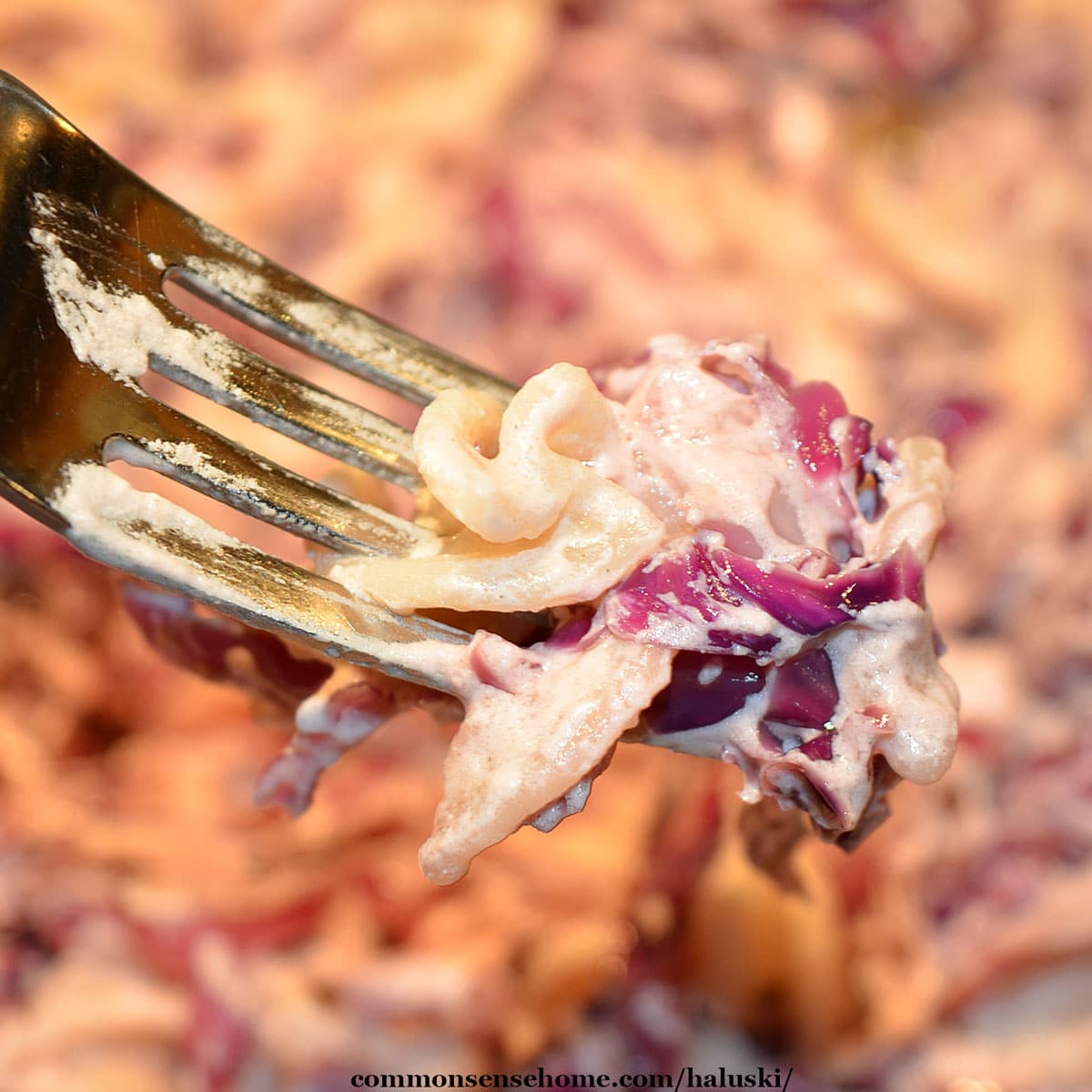
Note – I’m mixing photos from two different batches of haluski in this post, so that’s why some photos have green cabbage and some have red.
Haluski Recipe (Cabbage and Noodles)
Adapted from The Garden-Fresh Vegetable Cookbook by Andrea Chesman.
Ingredients
- 1/2 cup butter
- 1 medium head cabbage (about 2 pounds)
- 1 large onion
- 1 pound egg noodles (or Tinkyada GF noodles)
- 1 pound carton sour cream
- Salt and black pepper
Directions
Bring a large pot of salted water to boil for the noodles. Meanwhile, cut onion in half and slice thinly.
Place butter in a large skillet over medium heat. Add the onions and sauté until they start to get tender and caramelize.
While onions are cooking, thinly slice or shred your cabbage. Aim for uniform slices/shreds for even cooking. Add cabbage to pan with onions and butter.

Cook the cabbage and onions on medium high for 15-30 minutes, stirring occasionally, until tender and showing a bit of browning.
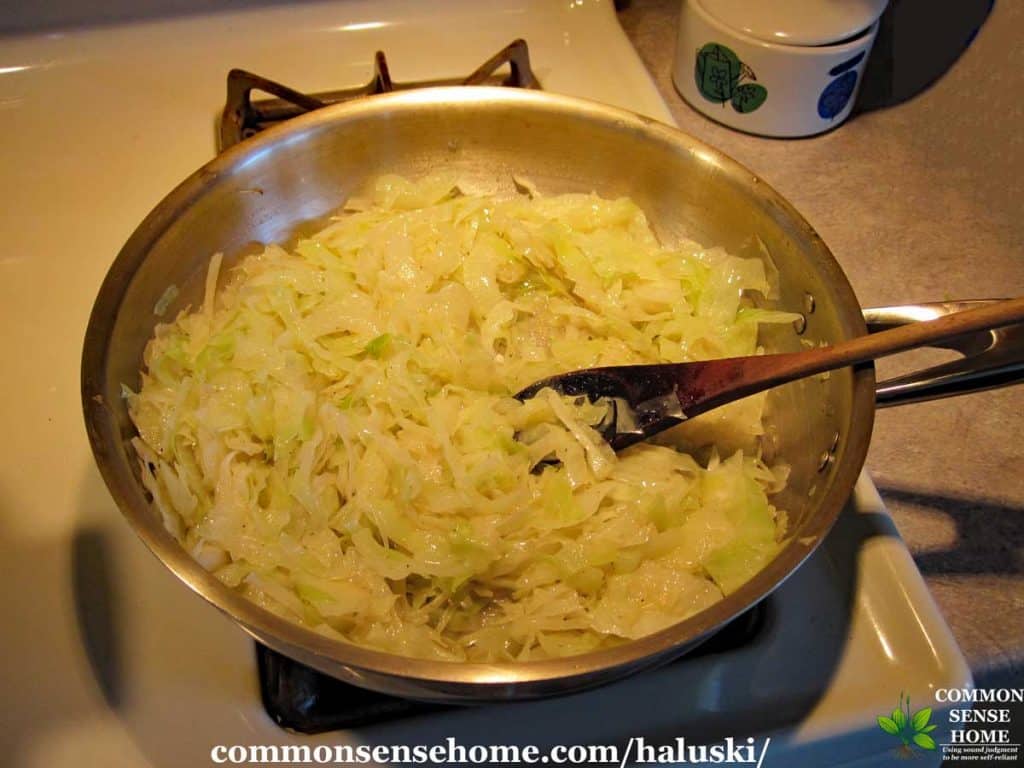
Meanwhile, cook noodles according to package directions. Aim for “al dente”, not well done, so they hold up better in the finished haluski. Drain well.
Add the noodles to the fried cabbage mixture (or the cabbage mix to the noodles, whichever way it fits better) and mix well. Add the sour cream and stir until distributed over the noodles and cabbage. Season with salt and pepper and serve immediately. Serves 6-10.
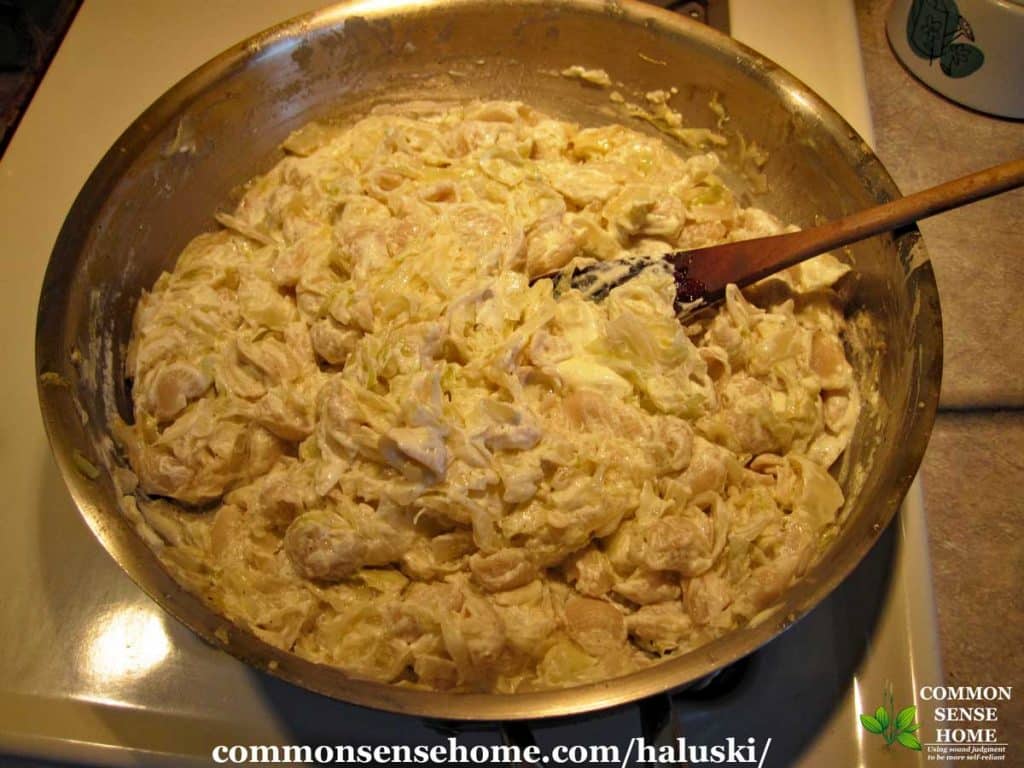
How to Cut Cabbage for Haluski
The most important thing to keep in mind when cutting your cabbage is to keep the pieces roughly even in size. That way you don’t end up with half raw or half turning to mush.
One of the easiest ways to cut up the cabbage is to start by quartering it and removing the core. Then take each quarter and cut it into strips.
Would you like to save this?
Depending on who’s playing sous chef in the kitchen, our strips vary in width from around half an inch to around a quarter of an inch. Both options work fine. Wider strips are faster to cut, thinner strips are faster to cook.
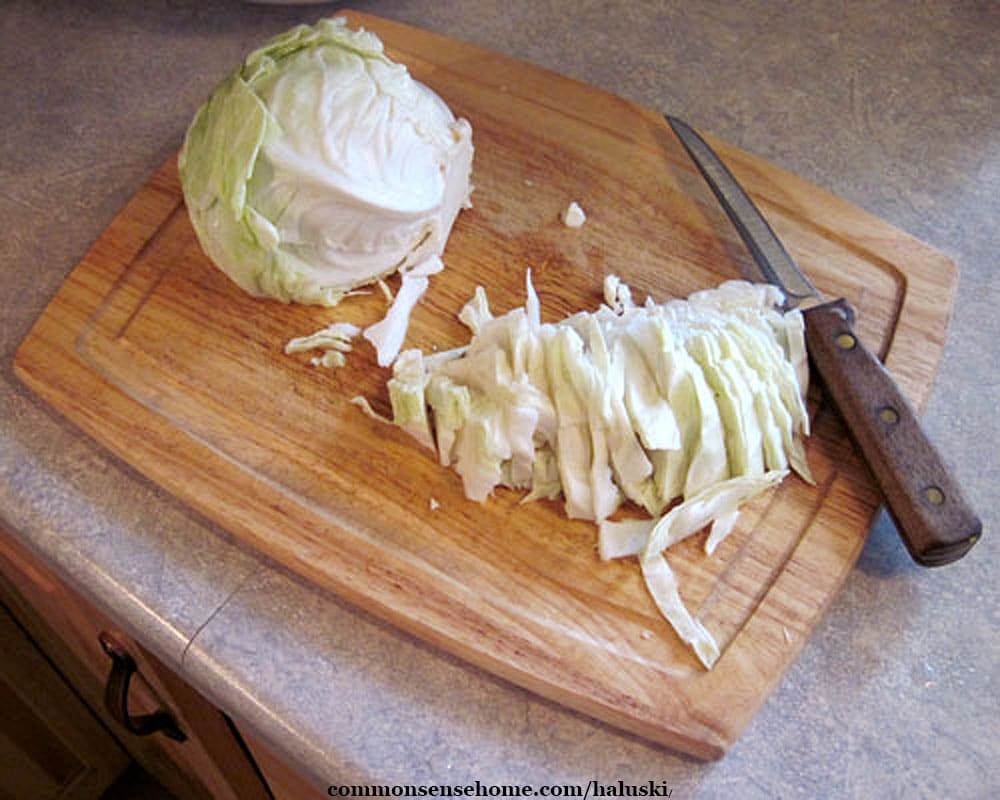
If you need to save time, you could pick up a package of pre-shredded cabbage for cole slaw. Those packages typically hold between 10-16 ounces, so you’ll need a couple of them to make a full batch of haluski.
Variations and Substitutions – Dairy Free, Gluten Free
To reduce the carb count, skip the noodles and cut the sour cream by about half. 1 cup of cooked cabbage has around 8.3 grams of carbohydrates, 2 tablespoons of sour cream has 1.3 grams of carbohydrates, and a half cup of onions contains around 3.5 grams.
For dairy free, cook the cabbage in lard or refined coconut oil, and try a dairy free sour cream. The flavor will be a little different, but you should still get that creamy texture.
You can reheat your haluski on the stovetop or in the microwave (or just eat it cold), but don’t overheat it or the sour cream will break and ruin the texture.
Making gluten free haluski is easy with the rice noodles instead of wheat noodles. Lately I’ve been using the Tinkyada Brown Rice Spirals , but wide egg noodles are more traditional.
Lightly browning your onions and cabbage is important. It really adds that “extra something” to the flavor of the dish.
What to Serve with Haluski
Because we already have starch and vegetables in the haluski, we usually pair it up with meat. I like burgers or sausage, including the classic, kielbasa.
To turn your haluski into a full meal, just add some sliced kielbasa. Simply slice your kielbasa and add it to the cabbage and onion mixture near the end of cooking to heat through.
If you’d like some added browning, feel free to grill the kielbasa or fry it separately before adding it to the dish.
Keep in mind that we have a rich, starchy dish, so it works best with a strong flavored meat. Chicken sauce is a much batter match than boneless, skinless chicken breast.
A side salad with a vinegar or lemon dressing to add acidity to meal works. Or better yet, try some pickled vegetables, like pickled beets or dilly beans.
For a special dessert to wrap up the meal, bake up some Hungarian nut rolls or Czech kolache.
PrintHaluski – Cabbage and Noodles
Rich and creamy, budget friendly comfort food. My boys’ favorite way to eat cabbage.
Ingredients
- 1/2 cup butter
- 1 medium head cabbage
- 1 large onion
- 1 pound egg noodles (or Tinkyada GF noodles)
- 1 pound carton sour cream
- Salt and black pepper
Instructions
- In a large stockpot, put water to boil for noodles. Meanwhile, cut onion in half and slice thinly.
- Place butter and onion in large frying pan or Dutch oven. Sauté onions over medium heat until onions start to get tender and caramelize.
- While onions are cooking, thinly slice or shred your cabbage. Aim for uniform slices/shreds for even cooking. Add cabbage to pan with onions and butter.
- Cook the cabbage and onions 15-30 minutes, flipping and mixing regularly, until tender and showing a bit of browning.
- Meanwhile, cook noodles according to package directions. Aim for “al dente”, not well done, so they hold up better in the finished haluski. Drain well.
- Add the noodles to the cabbage mix (or the cabbage mix to the noodles, whichever way it fits better) and mix well. Add the sour cream and stir until distributed throughout the dish. Season with salt and pepper and serve immediately. Serves 6-10.
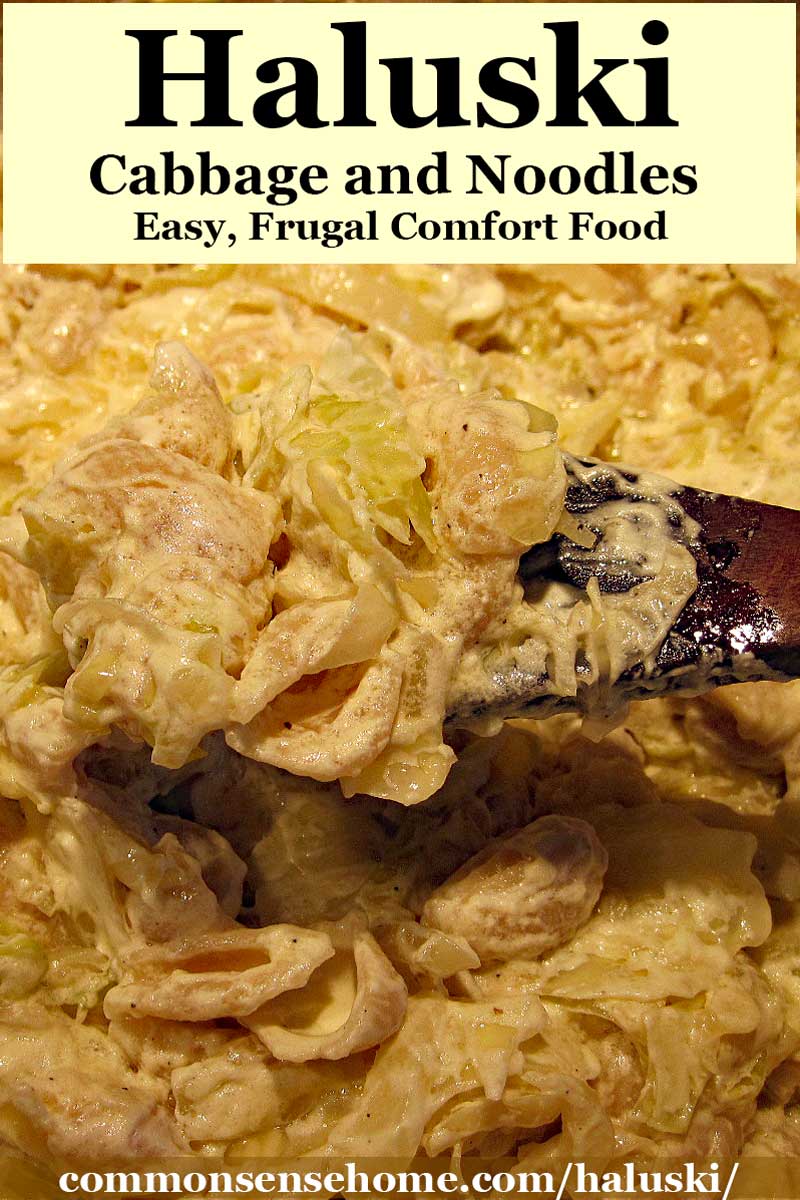
More Comfort Food Recipes
We have dozens of easy to make comfort food recipes on the site, including:
Note: This recipe was originally published as “haluska”, but was updated to “haluski” as that is the more common spelling.
Originally published in 2012, last updated in 2023.


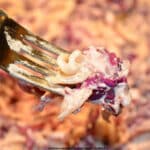
That sounds so delish, I will have to try it! I have a good case of Sour Cream Love myself! Our grocery store chain stocks a fabulous brand from Texas that is pure cream, no chemical tricks, and totally digestible, unlike those chemistry-laden brands. I am working at convincing my husband that chronic inflammation often accompanies fool-you chemicals and texturizers. My diet includes a lot of cream and butter. At 5’2″, moderately active and just turned 70. I have weighed about 112 to 115 pounds for over 40 years since I quite eating sucrose and chemically laden food. Fillers, texturizers and coloring and flavorants crept into our diets starting when I was born, and research pathologists for some reason do not tell us that the composition of tumors, which are receptacles for additives we cannot digest are laden with these chemicals. There is soan extra mote of you in the way your write your recipe articles, no doubt from the joy of fresh food you have put your love, care and wisdom into, and can eat with confidence that it will only feed you and your family health and happiness!
We normally use Organic Valley sour cream. Like you, my guts don’t respond will to many of the fillers and binders in some other brands.
Our family loved it! One of my good friends made it for her family and posted it because it is definitely a winner!
I’m glad you enjoyed, and thank you for making time to leave a positive review. It really helps with recipe visibility in search engines.
I make cabbage “fried” in butter with noodles. I never thought of adding sour cream! I am going to post my beirocks recipe this month. You may enjoy that. We used to get them at our county fair. They use one head of cabbage. ;D They freeze nicely, a plus.
I have seen recipes for beirocks, but haven’t tried them yet.
This sounds delicious! It has all the same things I use when I make sauerkraut perogies, just in a different form. Yum!
Believe it or not, I have never made perogies, although I have had them served at community functions. Pure comfort food.
When I make cabbage noodles I add a handful of cream of wheat when browning the cabbage and onions. It adds a nutty flavor to the dish. The recipe was given to me by my mother-in-law, whose family is from Magyarpolany, Hungary.
That is interesting. I’ve never heard of that before.
I do the cabbage and onions, sometimes I add kolbasi that has been browned.
Instead of noodles try using onion and potatoe perogies that have been fried until defrosted!
Add sour cream ….yum
I love perogies!
How many cups of sour cream?
It is not sold in cartons or pounds here – just plastic with metric measurements.
It’s about 2 cups. My container says 454 grams.
Good evening dear, I love all your post. With all the bad news on tv I couldn’t sleep so I’m looking over my e-mail. I’m reading about your coming thanksgiving and your mom and low and behold I see your recipe. You had me looking back to the sweet times I spent with my grandma. She would make her own egg noodles for everything and just the smell of brown butter onions will bring tears to my eyes. When she had cabbage ready in her garden I knew what was coming. We would spend hours talking, her showing me how to cook, I long for those day now. Anyway…….your recipe has sour cream, hers never did but the next time I will shirley try it. Bless your heart and your home and family. And make good food and with good memories for your kids, they will remember.
Thank you, Karen. The boys are pretty good help in the kitchen now, and they love showing off their cooking and the things they grew in “their garden” to grandma and grandpa. Above all, they appreciate the taste of good food, simply prepared, shared with good company. I am thankful that we are once again able to eat supper as a family every night since my husband is home again. Thank you for sharing your memories.
Can the haluska be frozen after cooking and cooled?
I haven’t tried it, but I don’t believe it would work very well because the sour cream would separate and get clumpy.
Just made this and almost followed the recipe except I added 8 ounces of softened cream cheese and WOW!! This is some good stuff. Thanks for sharing!
You’re welcome! Pairing up with sour cream and cheese helps the body absorb the fat soluble vitamins, too.
My family background is eastern european (Hungarian) and we make this with cabbage, onions, cooked bacon pieces and noodles – cooked, put altogether and baked in the oven. I look forward to trying your version!
That sounds good, too!
Laurie,
After hearing about this a couple of times on your page and then my son had cabbage at a friends for their New Year’s meal. I am braving trying it. Houston actually is having some cooler weather and rainy so am hoping for a “comfort” food appeal. <3 what you have done with the website. Hope your weekend is wonderful and full of happy memories.
Woot! Woot! I hope your family (and you) enjoy it!
My mom used to make this for us as children! Funny though, she was irish.
Cabbage love spans many cultures. 🙂
That DOES sound good. I had a roomate in college who was Dutch (family immigrated). Her Mom made something with mashed potatoes, cabbage and bacon that was incredible.
I think it’s time to pick up some cabbage.
Several folks have suggested adding bacon. I think next time I’ll have to try it. 🙂
Love this site, but this is the first time I’ve commented. I meant to tell Brigid that most recipe sites will include colcannon recipes. Only 4 ingredients, plus salt and/or pepper: mashed potatoes, fried cabbage, onions and bacon.
Brigid …Potatoes prepared the way you describe is called Colcannon and was one of the ways the Irish varied their ways to cook them during their famine, according to what I read.
Laurie made this for dinner last Monday. It was delicious!!
She gave me a head of cabbage from her garden so I can try this recipe at our home. All attending her dinner had second and third helpings!
Mother-in-law Jane
Thanks Laurie
Laurie,
This sounds wonderful! It might even convert my cabbage disliking hubby into a cabbage lover 🙂 I have way more cabbage than I can use in salads for my son and myself…so I will have to add sour cream to the grocery list!
Thanks for sharing 🙂
I wonder if plain yogurt would work instead of the s. cream
Bobbi – I’m sure it would be similar, especially if you used a thicker or strained yogurt.
If you needed to be dairy free you can make a nice creamy sauce with veggie stock, olive oil and nutritional yeast. It is very flavorful and sort of “cheesy” in a not cheese way. My kids love the stuff.
I had to make this! But of course, did not have sour cream and only lasagna noodles inda house. So, used plain non-fat sour cream and 3-4 T. cream cheese and broke up the lasagna. It’s delishous! I been a huge fan of sauteed cabbage and onions to a nice carmelized stage for many years but your recipe puts this right over the top! Oh and I had to use olive oil, outa BUTTA! STill really good. Thanks and keep up the good work.
Sometimes you need to improvise. 🙂 Good food is still good food.
Hi Laurie – I’m a cabbage virgin. This is the first year I’ve attempted growing it. And now finding what to DO with it all is the challenge. Thank you for this recipe – can’t wait to try it.
Question: How do you best remove all the grit and critters from the cabbage before processing it?
I generally strip off the outside leaves, which gets rid of quite a few hitchhikers. Then I rinse in cold water. You can keep an eye out for any unwanted guests and pick them off and trim damaged areas as you process.
I bet you could experiment with potatos instead of noodles as well. Yumm …